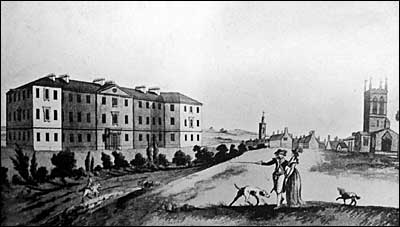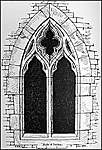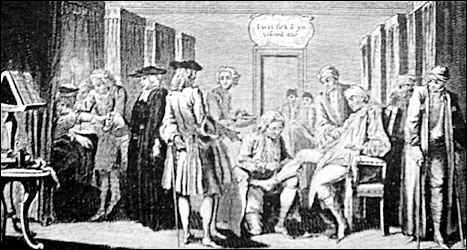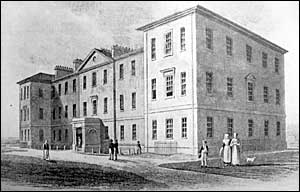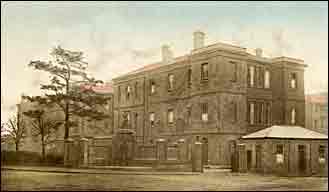| Northamptonshire Notes & Queries Vol.II Edited by Christopher Markham F.S.A. |
|||||||||||||||||||||||||||||||||||||||||||||
|
|||||||||||||||||||||||||||||||||||||||||||||
Mr. John Rushworth, a surgeon, residing in Northampton, in a pamphlet published in 1731 and addressed to the Surgeons' Company, described the usage, first discovered by himself, of Peruvian bark in mortification; and in a postscript he urged the desirability of Parliament assisting in the erection of an Infirmary in the centre of every County. At this time there were no local infirmaries in England, and nothing was done to carry out Mr. Rushworth's suggestions for many years. But when Dr. Stonehouse came to the town in April 1743, he made a strong effort to establish an infirmary. By the 1st July he had printed and circulated papers advocating this proposal, and these were advertised in the Northampton Mercury for 18th July, 1743. Ultimately it was arranged that the subject should be brought before the Grand Jury at the Summer Assizes, which were held at Northampton on the 21st July 1743. On the 20th September the same year "a general and very Great Meeting of the Nobility, Gentry and Clergy" was held at the Red Lyon Inn, then an important house situated at the South-west corner of Sheep Street. At this meeting, the Infirmary or Hospital was established, and the Governors took a house in George Row upon a lease, at a rent of £30 a year, with the option of purchasing the same.
The house for the hospital having been obtained and fitted up, the Committee met there for the first time on 10th December 1743. This house adjoined and was on the west side of the County Gaol. In the west end of the gable of this building is a beautiful pointed window, in the late Decorated style, of about 1350. This window is of two lights, the height being 5 feet 11 inches, and the width 2 feet 10 inches:
The first officers of the Hospital were-:
When the County Infirmary opened on Thursday, the 29th March 1744, for the reception of patients, the Rev. Richard Grey, D.D. Rector of Hinton-in-the-Hedges, preached a sermon in All Saints' Church. A description of a painting of the interior of one of the wards.
Four beds on each side draped with heavy hangings, which would not at all conform to modern ideas. The Physician, wearing the dress of the period, with periwig and three-cornered hat, his gold-headed cane suspended from his left wrist, and a sword by his side. The surgeons are in attendance. One is bleeding a patient and the other bandaging a leg: there is a clerical looking individual, who may be one of the incumbents in the town. An appeal was made to the medical men in the town for assistance in carrying on the work of the charity, and these gentlemen, while professing to be ready to help, were all very jealous of one another, and many complaints were made, especially against Dr. Stonehouse and Mr. Lyon. The hospital was estimated to accommodate eighty patients, but, as a matter of act, when it was opened there were only thirty beds, though ten were added the next year.
When the house was opened there were four diets prescribed for the patients, namely full diet, low diet, milk diet, and dry diet. Full diet. Low diet. Milk diet. Dry diet.
Millet was no doubt a porridge made from millet meal. White pot was a dish made of cream, sugar, rice, currants, cinnamon and other spices.
The first Report of the Hospital was issued in October, 1744. This document gives account of the founding of the institution, and continues:- "A large house was immediately "taken in Northampton, the situation of which for air, as well as all sorts of requisites for an hospital, is preferable to almost any in England." It also gives the following state of the patients:- In-patients admitted from 29th March to the 1st September 1744:
Indentures of Lease & Release In 1748 the house, which was already occupied, was conveyed by Indentures of Lease and Release " In consideration of the sum of seven hundred and fifty pounds. "A messuage with the yards gardens and other appurtenances situate in the Parish of All Saints in the Town of Northampton formerly an Inn," in trust to permit the same to be made use of as an Hospital or Infirmary. It does not however appear what sign this old inn bore.
The apothecaries were elected in a very curious manner. When there was a vacancy an advertisement for such an officer was inserted in the local paper, and altered week by week as some fresh idea occurred to the Committee. The applications were dealt with as they came, till a candidate appeared who was satisfactory to the physicians, and then, when the arrangements had been duly completed between the candidate and the committee, the appointment was made. One of the advertisements, in June, 1761, ran thus:-
This valuable method of ending his days was to be rendered comfortable by the handsome salary of £40 per annum, and possibly and addition of £40 as a gratuity.
Click here for the listings of admissions of Burton Latimer residents between 1744 and 1827 |
|||||||||||||||||||||||||||||||||||||||||||||
